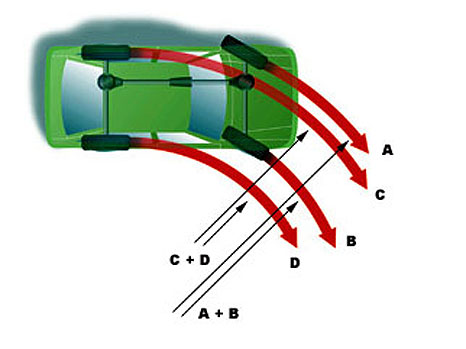 The need for different rpm on front and rear axles represents no problem for full time 4WD systems (also called permanent 4WD or constant 4WD). Remember, the combined rpm of front wheels (A+B) is higher than the combined rpm of the rear wheels (C+D).
The need for different rpm on front and rear axles represents no problem for full time 4WD systems (also called permanent 4WD or constant 4WD). Remember, the combined rpm of front wheels (A+B) is higher than the combined rpm of the rear wheels (C+D).
If you own a vehicle with full time 4WD the need for different rpm front and rear is satisfied by a center differential incorporated inside the transfer case. This third differential, in addition to the two axle differentials, allows the front and rear axles - front and rear drive shafts - to rotate at different rates when needed. Torque and rpm are distributed exactly as needed.
Full time systems allow all 4 tires to push or pull at maximum rate. In part time this is not the case.
This makes full time systems superior for on-road and off-road use.
That's where the name "full time" 4WD is coming from - it can be used all the time. No need to shift back into 2WD like in part time systems.
Full time 4WD: No wind up, no binding, no understeer, no skidding - always maximum pulling power. Also important: ABS as well ESP work the way they were designed. In part time they don't.
Full time 4WD is not to be confused with AWD.
However, all 4WD systems (part time or full time) only work best on level surfaces with equal traction on each tire. Once the terrain turns uneven (bumpy, deep ruts or holes) full time sytems lose all of their advantage. One spinning tire could render the entire vehicle motionless. In that case the center differential needs to be locked (disabled). Locking the center differential in effect creates a part time 4WD system where both drive shafts are forced to rotate at equal speeds.
So, for off-road use the center diff on a full time system needs to be locked. Here is why.